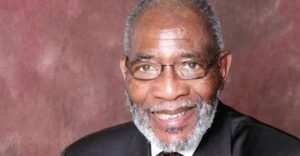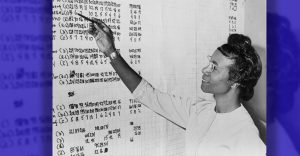#NNPA BlackPress
Inside The Hollywood Writers’ Strike
Hollywood’s writers are on strike — and the ongoing conflict may affect some of your favorite shows. The Writers Guild of America (WGA) is a labor union representing roughly 11,500 writers for TV and film. The Alliance of Motion Picture and Television Producers (AMPTP) represents eight major studios: Amazon, Apple, Disney, Netflix, Sony, Warner Brothers, […]
The post Inside The Hollywood Writers’ Strike first appeared on BlackPressUSA.

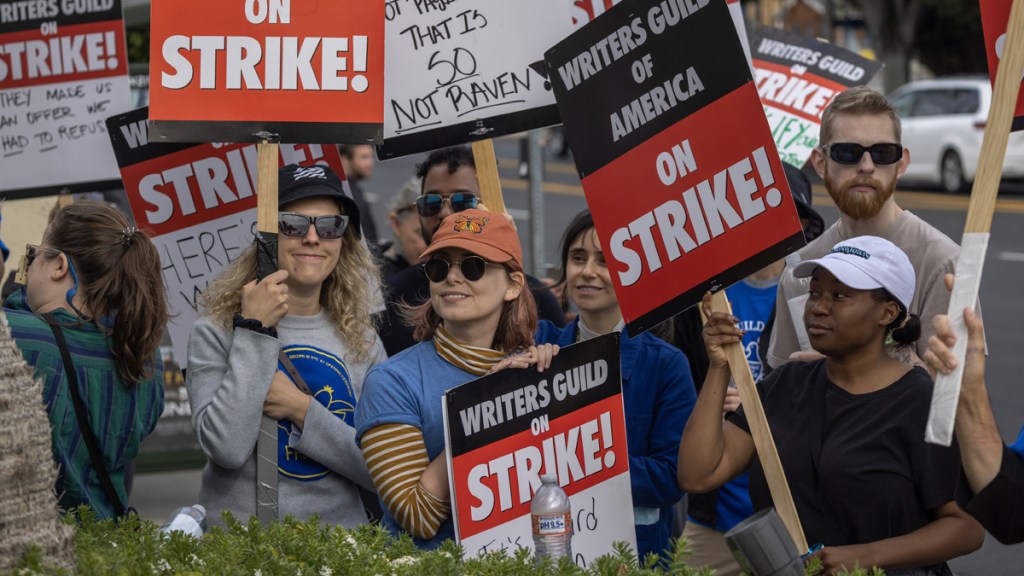
Hollywood’s writers are on strike — and the ongoing conflict may affect some of your favorite shows.
The Writers Guild of America (WGA) is a labor union representing roughly 11,500 writers for TV and film. The Alliance of Motion Picture and Television Producers (AMPTP) represents eight major studios: Amazon, Apple, Disney, Netflix, Sony, Warner Brothers, NBC Universal, and Paramount. Disagreements between the two sides have led writers to walk off the job, in their first strike since 2007.
After six weeks of negotiation with AMPTP, the WGA announced that members would go on strike starting at 12:01 AM on May 2. This means that no WGA member will write any new scripts for TV shows or movies until the WGA votes to end the strike. (Those who work in radio, streaming news, or public TV will stay on the job, according to Vox Media.) The goal of the strike is to force the AMPTP to negotiate a new deal — preferably one that honors the union’s requests.
The WGA negotiates a new contract with the studios every three years. But negotiations have broken down this time because the sides are so far apart. “The WGA Negotiating Committee began this process intent on making a fair deal, but the studios’ responses have been wholly insufficient given the existential crisis writers are facing. The companies’ behavior has created a gig economy inside a union workforce,” the WGA said in a statement. Back in April, the WGA voted — by a 97.85% margin — to authorize a strike if no deal was reached by May 1.)
At the core of the dispute are issues related to the rise of streaming services and the emergence of AI (artificial intelligence). These two technical changes present challenges for writers and their ability to make a living.
Streaming
Instead of traditional broadcast and cable TV, more and more people are turning to streaming services. Instead of watching CBS, NBC, or ABC, more viewers are watching online platforms like Hulu, Netflix, Amazon Prime, Paramount+, and HBO Max. Last year, streaming services got more viewers than cable or broadcast for the first time ever, per Nielsen. But this streaming boom has affected writers.
Before streaming, writers could make money by selling an idea for a film or TV series to a studio. TV executives would order a series and a “writers’ room” would assemble: a group of writers would gather to write about 20-22 episodes of a series. Writers could gain experience in their field and eventually move up to become showrunners. (According to MasterClass, a showrunner finalizes scripts, oversees budgets, selects/approves all writing staff, and assigns episodes to writers.)
Now, as streaming grows, studios have “mini-rooms” in which smaller groups (2-3 writers, as opposed to 7-8 or more) are hired to write episodes of a show before it even gets picked up. This saves studios money, but writers get paid less, and the often-combined roles of writing and production are separated. As Vox puts it: “The mini-room model makes writers as disposable as possible and ensures they’re not even around (and thus getting paid) when production begins.”
Streamers also order fewer episodes (6-10 versus 22), meaning writers are working for shorter periods of time. Writers work 20-24 weeks on streaming shows, as opposed to 29-40 weeks in network TV, per the WGA. That means writers are paid less for each job. This affects their rates of minimum basic agreement, or MBA — kind of like a minimum wage for writers, Vox says. The average weekly pay for the lowest-paid writers is roughly $4,500 a week, per Variety.) The chart below shows streaming’s effect on writers and their pay.

Median weekly writer-producer pay has declined 4% over the past decade. Adjusting for inflation, that’s a 23% drop. (When accounting for inflation, median screenwriter pay has declined 14% since 2018.) And despite working similar hours, showrunners also make less: median weekly pay for showrunners on streaming series is 46% lower than on broadcast shows.
So, writers are working less and taking home less pay on streaming shows. And income that would help them bridge the gap are also dwindling. That brings us to another issue: residuals. They’re like royalties for screenwriters. If you write for a show and a network buys the rights to air it, you get a check. If the show is popular and runs in syndication (like Friends, Living Single or even House of Payne), you receive a residual check — often a critical source of income for writers. But residuals for streaming series are lower than for broadcast.
The WGA has proposed improvements to these issues, as shown in the left column below. As you can see, the Guild and the AMPTP are still far apart on terms for an agreement.

The WGA has proposed minimums for writers’ room size and for employment span. But the AMPTP explained its resistance to the WGA’s proposal to institute a minimum size for writers’ rooms, as well as a minimum duration of employment. “While the WGA has argued that the proposal is necessary to ‘preserv[e] the writers’ room,’ it is in reality a hiring quota that is incompatible with the creative nature of our industry. We don’t agree with applying a one-size-fits-all solution to shows that are unique and different in their approach to creative staffing,” the AMPTP says.
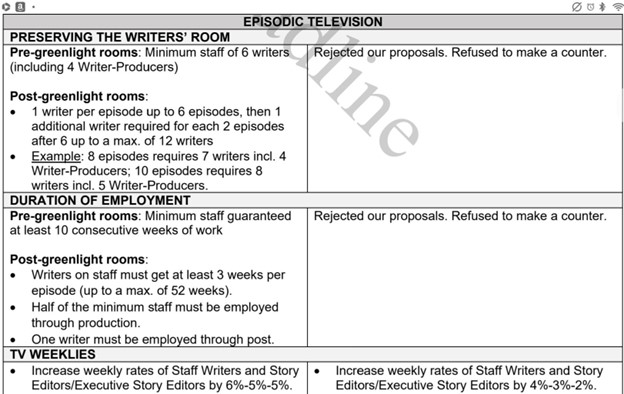
A.I.
Another issue for the writers is AI. Writers want strict limits on how artificial intelligence is used. Essentially, they don’t want to rewrite AI-generated material or have AI rewrite human scripts. There’s also concern that, someday, an AI tool could be used to generate a plot idea or script; then writers would be hired to revise (or “punch it up”) at a lower rate.
So, the WGA proposed limits on AI during negotiations. GQ explains: “The WGA proposed regulating the use of so-called generative AI in writers’ rooms—preventing AI from “writing” or changing material covered by the Minimum Basic Agreement, preventing it from being used as source material from adaptations, and ensuring that MBA material can’t be used to train these programs.” The AMPTP countered by offering “annual meetings to discuss advances in technology.”
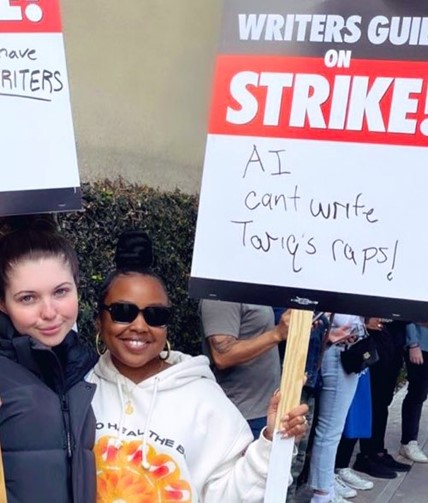
Quinta Brunson and protester (Photo via Twitter)
Strike Effects
So how will this strike affect all your favorite shows? It depends on what kind of shows they are. The season finale of NBC’s Saturday Night Live is still up in the air. Late-night talk shows are the first to be affected: The Tonight Show Starring Jimmy Fallon, The Late Show with Stephen Colbert, Jimmy Kimmel Live, Late Night with Seth Meyers, and The Daily Show will all go dark this week. The effect on streaming series has yet to be seen, but some broadcast shows have already altered course.
Writers for the ABC sitcom Abbott Elementary were supposed to start work on the third season on May 2 — the day the strike started. Now, when the show will resume production is unclear. “Everything is in flux because of the strike,” actress Sheryl Lee Ralph told TODAY. Series creator and star Quinta Brunson (who won an Emmy last year for writing the show’s pilot) issued statements of solidarity with her fellow writers.
Brunson tweeted on May 2: “I am a writer. I’m in the WGA. I’m also on strike! I have no real power here other than to join my union in demanding fair compensation for writers!” In another tweet, Brunson wrote, “This week you’ll probably find me on picket line. This strike also isn’t about me, and I don’t want to make it about me. It’s about all writers  support the WGA. No show or movie you love is written without… writers.”
support the WGA. No show or movie you love is written without… writers.”
The post Inside The Hollywood Writers’ Strike appeared first on Houston Forward Times.
The post Inside The Hollywood Writers’ Strike first appeared on BlackPressUSA.
#NNPA BlackPress
LIHEAP Funds Released After Weeks of Delay as States and the District Rush to Protect Households from the Cold
BLACKPRESSUSA NEWSWIRE — The federal government has released $3.6 billion in home heating assistance after a delay that left states preparing for the start of winter without the program’s annual funding.
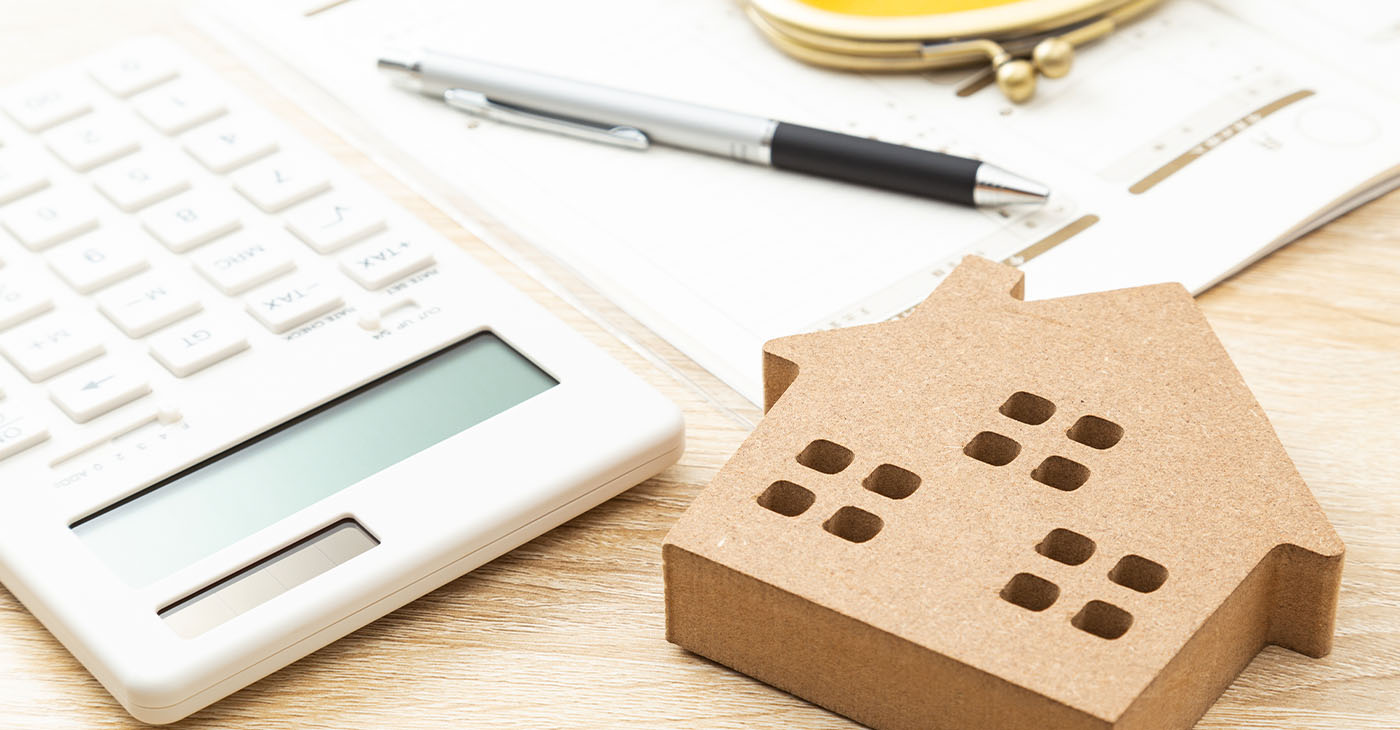
By Stacy M. Brown
Black Press USA Senior National Correspondent
The federal government has released $3.6 billion in home heating assistance after a delay that left states preparing for the start of winter without the program’s annual funding. The Low-Income Home Energy Assistance Program, known as LIHEAP, helps eligible households pay heating and cooling bills. The release follows a shutdown that stretched 43 days and pushed agencies across the country to warn families of possible disruptions.
State officials in Minnesota, Kansas, New York, and Pennsylvania had already issued alerts that the delay could slow the processing of applications or force families to wait until December for help. In Pennsylvania, more than 300,000 households depend on the program each year. Minnesota officials noted that older adults, young children, and people with disabilities face the highest risk as temperatures fall.
The delay also raised concerns among advocates who track household debt tied to rising utility costs. National Energy Assistance Directors Association Executive Director Mark Wolfe said the funds were “essential and long overdue” and added that high arrearages and increased energy prices have strained families seeking help.
Some states faced additional pressure when other services were affected by the shutdown. According to data reviewed by national energy advocates, roughly 68 percent of LIHEAP households also receive nutrition assistance, and the freeze in multiple programs increased the financial burden on low-income residents. Wolfe said families were placed in “an even more precarious situation than usual” as the shutdown stretched into November.
In Maryland, lawmakers urged the Trump administration to release funds after the state recorded its first cold-related death of the season. The Maryland Department of Health reported that a man in his 30s was found outdoors in Frederick County when temperatures dropped. Last winter, the state documented 75 cold-related deaths, the highest number in five years. Rep Kweisi Mfume joined more than 100 House members calling for immediate federal action and said LIHEAP “is not a luxury” for the 100,000 Maryland households that rely on it. He added that seniors and veterans would be placed at risk if the program remained stalled.
Maryland Gov. Wes Moore used $10.1 million in state funds to keep benefits moving, but noted that states cannot routinely replace federal dollars. His administration said families that rely on medical equipment requiring electricity are particularly vulnerable.
The District of Columbia has already mapped out its FY26 LIHEAP structure in documents filed with the federal government. The District’s plan shows that heating assistance, cooling assistance, weatherization, and year-round crisis assistance operate from October 1 through September 30. The District allocates 50 percent of its LIHEAP funds to heating assistance, 10 percent to cooling, 13 percent to year-round crisis assistance, 15 percent to weatherization, and 10 percent to administrative costs. Two percent is used for services that help residents reduce energy needs, including education on reading utility bills and identifying energy waste.
The District’s plan lists a minimum LIHEAP benefit of $200 and a maximum of $1,800 for both heating and cooling assistance. Crisis benefits are provided separately and may reach up to $500 when needed to resolve an emergency. The plan states that a household is considered in crisis if it has been disconnected from energy service, if heating oil is at 5 percent or less of capacity, or if the household has at least $200 owed after the regular benefit is applied.
The District’s filing notes that LIHEAP staff conduct outreach through community meetings, senior housing sites, Advisory Neighborhood Commissions, social media, posters, and mass mailings. The plan confirms that LIHEAP applicants can apply in person, by mail, by email, or through a mobile-friendly online application and that physically disabled residents may request in-home visits.
As agencies nationwide begin distributing the newly released funds, states continue working through large volumes of applications. Wolfe said LIHEAP administrators “have been notified that the award letters have gone out and the states can begin to draw down the funds.”
#NNPA BlackPress
Seven Steps to Help Your Child Build Meaningful Connections
BLACKPRESSUSA NEWSWIRE — Swinging side by side with a friend on the playground. Sharing chalk over bright, colorful sidewalk drawings. Hiding behind a tree during a spirited game of hide-and-seek. These simple moments between children may seem small, but they matter more than we think

By Niyoka McCoy, Ed.D., Chief Learning Officer, Stride/K12
Swinging side by side with a friend on the playground. Sharing chalk over bright, colorful sidewalk drawings. Hiding behind a tree during a spirited game of hide-and-seek. These simple moments between children may seem small, but they matter more than we think: They lay the foundation for some of life’s most important skills.
Through everyday play, young children begin learning essential social and emotional skills like sharing, resolving conflicts, showing empathy, and managing their emotions. These social skills help shape emotional growth and set kids up for long-term success. Socialization in early childhood isn’t just a “nice-to-have”—it’s essential for development.
Yet today, many young children who haven’t yet started school aren’t getting enough consistent, meaningful interaction with peers. Research shows that there’s a decline in active free play and peer socialization when compared to previous generations.
There are many reasons for this. Children who are home with a parent during the day may spend most of their time with adults, limiting opportunities for peer play. Those in daycare or preschool may have restricted free play, and large classrooms can reduce supervision and social coaching. Some children live in rural areas, are homebound due to illness, have full schedules, or rely on screens to fill their playtime. And for some families, finding other families with young children to connect with isn’t easy.
While these challenges can feel significant, opportunities for connection still exist in every community. Families can take simple steps to help children build friendships, create a sense of belonging, and strengthen social skills. Here are some ideas to get started:
- Storytime sessions at libraries or local bookstores
- Community offerings such as parent-child workshops, art, music, gymnastics, swimming, or sports programs
- Weekly events at children’s museums, which may include art projects, music workshops, or science experiments
- Outdoor exploration, where kids can play with peers
- Local parenting groups that organize playdates and group activities
- Volunteer opportunities where children can participate, such as pet adoption events or packing meals at a food bank
- Classes for kids at local businesses, including hardware, grocery, or craft stores
Some of these community activities are free or low-cost and give kids the chance to build friendships and practice social skills. Parents can also model positive social behavior by interacting with other parents and encouraging their children to play with their peers.
These may seem like small moments of connection, but they can have a powerful impact. Every time your child shares a toy, plays make-believe with peers, or races a friend down the slide, they’re not just playing—they’re learning the skills that build confidence, empathy, and lasting friendships. And it’s good for you, too. Creating intentional opportunities for play also helps you strengthen your own network of parents who can support one another as your children grow together.
#NNPA BlackPress
Seven Steps to Help Your Child Build Meaningful Connections
BLACKPRESSUSA NEWSWIRE — Swinging side by side with a friend on the playground. Sharing chalk over bright, colorful sidewalk drawings. Hiding behind a tree during a spirited game of hide-and-seek. These simple moments between children may seem small, but they matter more than we think
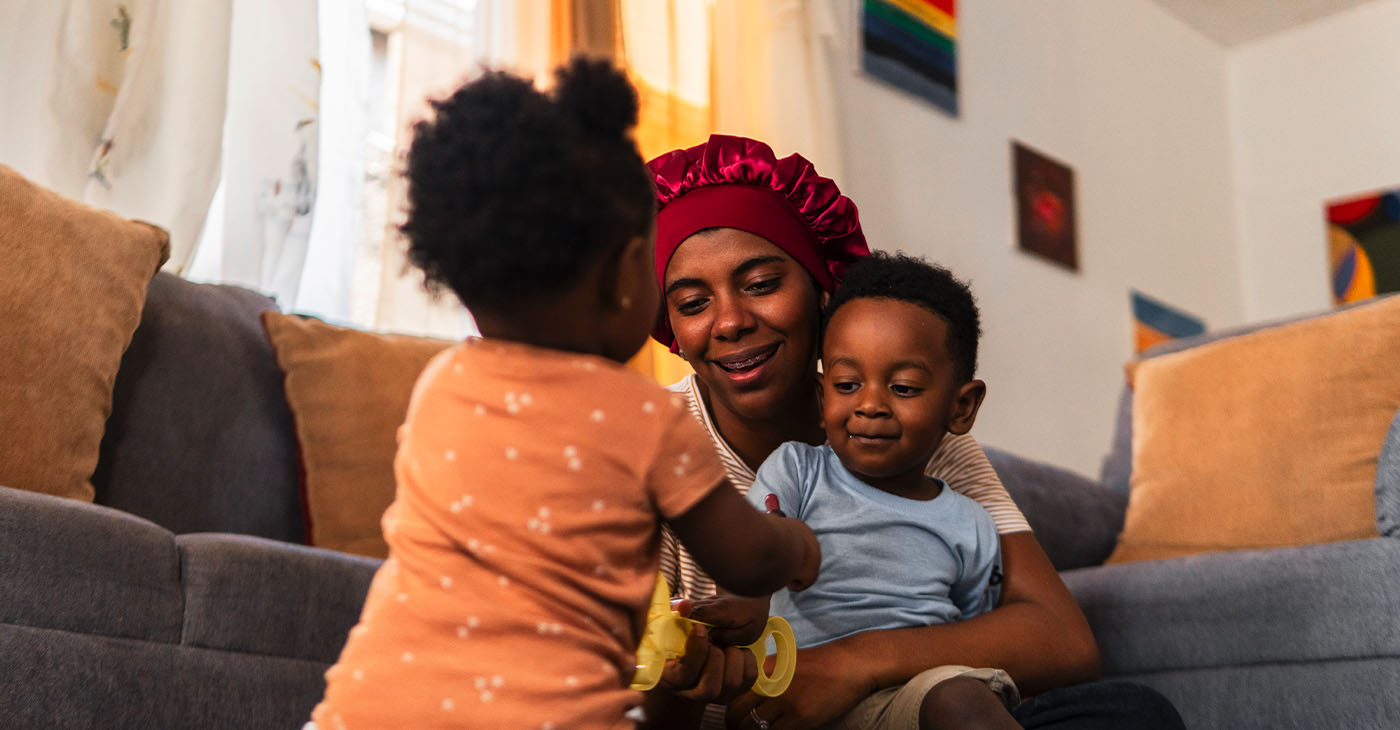
By Niyoka McCoy, Ed.D., Chief Learning Officer, Stride/K12
Swinging side by side with a friend on the playground. Sharing chalk over bright, colorful sidewalk drawings. Hiding behind a tree during a spirited game of hide-and-seek. These simple moments between children may seem small, but they matter more than we think: They lay the foundation for some of life’s most important skills.
Through everyday play, young children begin learning essential social and emotional skills like sharing, resolving conflicts, showing empathy, and managing their emotions. These social skills help shape emotional growth and set kids up for long-term success. Socialization in early childhood isn’t just a “nice-to-have”—it’s essential for development.
Yet today, many young children who haven’t yet started school aren’t getting enough consistent, meaningful interaction with peers. Research shows that there’s a decline in active free play and peer socialization when compared to previous generations.
There are many reasons for this. Children who are home with a parent during the day may spend most of their time with adults, limiting opportunities for peer play. Those in daycare or preschool may have restricted free play, and large classrooms can reduce supervision and social coaching. Some children live in rural areas, are homebound due to illness, have full schedules, or rely on screens to fill their playtime. And for some families, finding other families with young children to connect with isn’t easy.
While these challenges can feel significant, opportunities for connection still exist in every community. Families can take simple steps to help children build friendships, create a sense of belonging, and strengthen social skills. Here are some ideas to get started:
- Storytime sessions at libraries or local bookstores
- Community offerings such as parent-child workshops, art, music, gymnastics, swimming, or sports programs
- Weekly events at children’s museums, which may include art projects, music workshops, or science experiments
- Outdoor exploration, where kids can play with peers
- Local parenting groups that organize playdates and group activities
- Volunteer opportunities where children can participate, such as pet adoption events or packing meals at a food bank
- Classes for kids at local businesses, including hardware, grocery, or craft stores
Some of these community activities are free or low-cost and give kids the chance to build friendships and practice social skills. Parents can also model positive social behavior by interacting with other parents and encouraging their children to play with their peers.
These may seem like small moments of connection, but they can have a powerful impact. Every time your child shares a toy, plays make-believe with peers, or races a friend down the slide, they’re not just playing—they’re learning the skills that build confidence, empathy, and lasting friendships. And it’s good for you, too. Creating intentional opportunities for play also helps you strengthen your own network of parents who can support one another as your children grow together.
-

 Activism4 weeks ago
Activism4 weeks agoOakland Post: Week of November 12 – 18, 2025
-

 Activism3 weeks ago
Activism3 weeks agoIN MEMORIAM: William ‘Bill’ Patterson, 94
-

 Activism4 weeks ago
Activism4 weeks agoHow Charles R. Drew University Navigated More Than $20 Million in Fed Cuts – Still Prioritizing Students and Community Health
-

 Bay Area4 weeks ago
Bay Area4 weeks agoNo Justice in the Justice System
-

 #NNPA BlackPress3 weeks ago
#NNPA BlackPress3 weeks agoLewis Hamilton set to start LAST in Saturday Night’s Las Vegas Grand Prix
-

 #NNPA BlackPress3 weeks ago
#NNPA BlackPress3 weeks agoBeyoncé and Jay-Z make rare public appearance with Lewis Hamilton at Las Vegas Grand Prix
-

 Activism3 weeks ago
Activism3 weeks agoOakland Post: Week of November 19 – 25, 2025
-

 #NNPA BlackPress4 weeks ago
#NNPA BlackPress4 weeks agoThe Perfumed Hand of Hypocrisy: Trump Hosted Former Terror Suspect While America Condemns a Muslim Mayor














